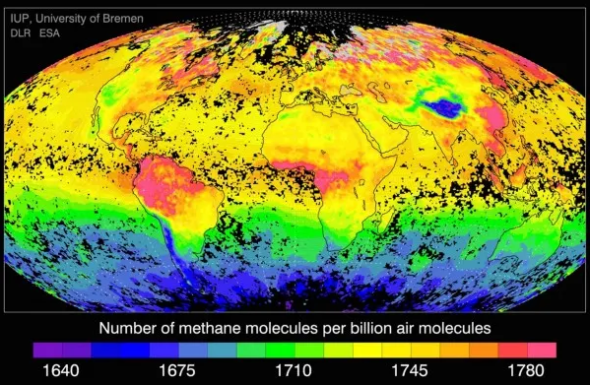The news about methane leaks recently published by Gazprom shows that this problem carries more importance for Russia than the fight with CO2 emissions. Soon EU regulations may challenge the gas industry in that country – Mariusz Marszałkowski, editor at BiznesAlert.pl, writes.
Methane is more dangerous than CO2
Methane emissions are becoming a serious problem in the context of the ongoing climate change. The discussion on the reduction of CO2 emissions, which is more headline worthy, ignores methane emissions, which according to the International Energy Agency is 85 times more harmful in the perspective of the next 20 years and 30 times more harmful in the next 100 years. According to the European Environment Agency, in the mid 2020s for the first time in history methane’s participation in GHG emissions into the atmosphere will be higher than carbon dioxide’s.
Whereas the IPPC data show that since 2010 methane emissions have constituted 16 percent of the entire GHG release into the atmosphere. This means in the last four decades that figure went up by 2.7 billion tons in absolute number. About 60 percent of methane emissions have an anthropogenic character, which means they are caused by humans. Globally, the agricultural sector is responsible for 45 percent of methane emissions and open landfills account for 20 percent. In case of the energy sector, the oil and gas sector is responsible for 54 percent of methane emissions.
When it comes to the emissions generated by individual continents the figures vary significantly. While in the EU agriculture is responsible for 54 percent of emissions and the power industry for 19, in Russia the proportions are completely different. In this country the energy sector generates 76 percent of the emissions, while agriculture only 6. Between 2000 and 2017 research was conducted, which revealed that in that period methane emissions increased by 20 percent and amounted to 8.6 billion tons of CO2 equivalent.
The scale of emission reduction in different countries is also unequal. While since 2000 methane emissions in the EU have gone down by 22 percent (one of the reasons being a decrease in domestic hydrocarbon production), in China the figure went up by 52 percent and in Russia by 40. To compare, CO2 emissions in the last two decades have soared by 40 percent across the world – China tops the list with a 270 percent increase, while in Russia the figure is 2.5 percent. However, in the EU the emissions dropped by 14 percent.
Where do methane emissions come from?
Methane emissions are generated both during gas transport, as well as during storage and extraction. In case of transport, leaky gas pipelines and the fact that they often lose their air-tightness are frequently the problem. Each year Gazprom needs to handle between a few and several large breakdowns of their main transport gas pipelines, excluding hundreds of the smaller malfunctions of distribution gas pipelines. Add to that methane leaks that happen during planned maintenance works. The biggest one since 2019 occurred in early June this year. As much as 1830 tons of methane were released to the atmosphere in result. Gazprom admitted to at least five leaks of this kind in May and June.
The problem also appears during the exploitation of deposits. A portion of the associated petroleum gas (APG) during the production of oil is captured and then processed into light petrochemical products. However, it is not economically profitable to process gas that comes out of a deposit which has a pressure of under 5 bars. This kind of gas is treated as a byproduct and is burned in droves in the so-called flares, which are built on oil and gas fields. In 2017 this practice was responsible for 14 percent of methane emissions into the atmosphere. Underground gas storages are another important source of methane emissions in Russia. In total Gazrpom uses 27 of such storage facilities, which can hold over 70 bcm of gas. Underinvestment and overexploitation of the storage facilities cause many leaks in, among others, compressors or other parts of the installations that pump in the gas. Breakdowns also happen because of the way the storage facilities are shaped. If a cavern has faulty physics, gas may slowly be released, which in result leads to methane emissions into the atmosphere.
According to research by Greenpeace Russia, gas losses caused by leaks may reach even 10 percent of the entire volume between the gas field and the consumer. Each year that figure may reach 50 bcm , which causes losses to the tune of RUB 15 billion (USD 890 million). According to official data included in Gazprom’s environmental report, at the end of 2019 the GHG emission from the company’s installations was at 117.09 million tons of CO2 equivalent, out of which 28 percent, i.e. 32.78 m tons of the CO2 equivalent, was methane.
Gazprom has also stated that this emission constitutes 0.02 percent of the entire extracted gas, 0.29 of gas in transport and 0.03 percent of gas in underground storage. However, it is worth pointing out that this is official data. Numerous research initiatives have revealed that methane emissions caused by the oil and gas sector is often higher than the operators and governments claim. According to research published n 2018 in the „Science” magazine, in 2015 the release of the odourless and colorless gas from the American oil and gas supply chain was around 60 percent higher than the estimates of the inventory conducted by the US Environmental Protection Agency.
The European Commission’s methane strategy
On the 14th of October the European Commission published the EU methane reduction strategy. Due to a decrease in extraction in the EU, the European Commission put special emphasis on measuring and reporting methane emissions from the gas transmitted in gas pipelines and LNG.
In this context the adopted strategy means the EU is taking a step towards establishing a new legal and regulatory framework, whose goal is to formalize and make the requirements on measuring and reporting emissions more strict in EU states. This includes norms pertaining to methane emissions for all fossil fuels sold in the EU. Such a policy suggests that the requirements for gas producers, including Gazprom, which is responsible for over 30 percent of gas delivered to Europe, will be tightened. The new tax on border emissions – CBAM may become part of this new legislative initiative. Apart from that, the strategy will also introduce a few monitoring mechanisms, including:
– Implementing mandatory data collection, measurement and monitoring of methane emissions and reporting in line with the methodological guidelines (Standard 2.0 among others) of the Oil and Gas Methane Partnership;
– Introducing an obligation to „improve leak detection and repair (LDAR) of leaks in all of natural gas infrastructure, as well as any other infrastructure that produces, transports or uses fossil gas, including as a feedstock”;
– Changing the EU law to eliminate „routine venting and flaring in the energy sector covering the full supply chain, up to the point of production”.
These changes mean that for Russia regulations on combating methane emissions may turn out to be more dangerous than the ones on CO2 emission reduction. Considering the latest news about new gigantic methane leaks Gazprom has admitted to, Russia has a lot of work to do.









